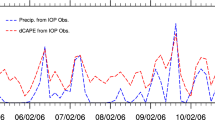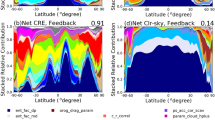Summary
Convection, a sub-gridscale process, is coupled to the gridscale motions via the averaged budget equations. In this study atmospheric convection is represented by the vertical eddy flux of equivalent temperature, referred to asconvective flux. It is demonstrated with a thermodynamic diagnostic model for an atmospheric column (DIAMOD) that the convective flux can, with tolerable error, be diagnosed from daily global gridscale analyses. These yield the gridscale budget of equivalent temperature. The budget is the observable quantity, it is in balance with the unobservable convective flux. We reproduce the known result that in convectively active atmospheric columns the budget is negative in lower and positive in upper layers. The corresponding vertical mean slope of the budget controls the convective strength; the slope is strongly negative for deep convection.
In the global mean column the convective flux converges upward throughout the entire atmosphere. In actual convective situations, however, the flux diverges in lower layers, reaches highest intensity somewhere between 700–500 hPa and converges in the upper atmosphere. We find maximum fluxes around 600 W/m2 in individual tropical columns and extreme fluxes exceeding 1000 W/m2 in midlatitude columns. In the monthly mean however, the convective flux is clearly larger in the tropics; it also reaches to significantly higher levels in the tropics than in midlatitudes. While these qualitative results are invariant against using both routine analysis and reanalysis data from different sources (ECMWF and NCEP) our results change quantitatively when changing the data sources. We attribute this effect to differences in the sub-gridscale parameterization implicit in the objective data assimilation of the weather centres which are not completely removed by the incoming observation data in the final analyses.
Similar content being viewed by others
References
Arakawa, A., Schubert, W. H., 1974: Interaction of a cumulus cloud ensemble with the large-scale environment Part I.J. Atmos. Sci.,31, 674–701.
Betts, A. K., 1974: Further comments on “a comparison of the equivalent potential temperature and the static energy”.J. Atmos. Sci.,31, 1713–1715.
Betts, A. K., 1978: Convection in the tropics. In: Shaw, D. B. (Ed.)Meteorology Over the Tropical Oceans. Bracknell: Roy. Meteor. Soc., pp. 105–132.
Betts, A. K., 1986: A new convective adjustment scheme. Part I: Observational and theoretical basis.Quart. J. Roy. Meteor. Soc.,112, 677–691.
Betts, A. K., 1997: The parameterization of deep convection. In: Smith, R. K. (Ed.)Physics and Parameterization of Moist Atmospheric Convection, pp. 255–279. NATO ASI Series.
Betts, A. K., Miller, M. J., 1986: A new convective adjustment scheme. Part II: single column tests using GATE wave, BOMEX, ATEX and arctic air mass datasets.Quart. J. Roy. Meteor. Soc.,112, 693–706.
Binder, P., Schär, C., 1996: MAP design proposal, 2nd edn. Available from MAP data centre, ETH Zürich, Switzerland.
Calanca, P., Fortelius, C. 1996: Representation of model data and evaluation of diagnostic equations is pressure coordinates.Tellus,48A, 756–766.
Dorninger, M., 1997:Der konvektive Wärmefluß bei verschiedenen synoptischen Lagen. Ph.D. thesis, University of Vienna, 162pp.
Dorninger, M., Ehrendorfer, M., Hantel, M., Rubel, F., Wang, Y., 1992: A thermodynamic diagnostic model for the atmosphere. Part I: Analysis of the August 1991 rain episode in Austria.Meteorol. Z., N. F.,1, 87–121.
Dorninger, M., Hantel, M., 1996: Total convective heat fluxes for different weather situationsMAP Newsletter 5, 20–21.
Dudhia, J., 1993: A nonhydrostatic version of the Penn State/NCAR mesoscale model: Validation tests and simulation of an Atlantic cyclone and cold front.Mon. Wea. Rev.,121, 1493–1513.
Emanuel, K. A., Raymond, D. J., (eds.), 1993:The Representation of Cumulus Convection in Numerical Models, Vol. 24.Meteorol. Monographs. AMS, 246 pp.
Emeis, S., 1986: Subsynoptic vertical energy fluxes in midlatitude cyclones.Meteorol. Rdsch.,39, 161–172.
Gibson, J. K., Kållberg, P., Uppala, S., 1996: The ECMWF Re-Analysis (ERA) project.ECMWF Newsletter,73, 7–17.
Gregory, D., 1997: The mass flux approach to the parameterization of deep convection. In: Smith, R. K. (Ed.).The Physics and Parameterization of Moist Atmospheric Convection. NATO ASI Series.
Haimberger, L., Hantel, M., 1996: Convection driven by the linearized gridscale moist enthalpy budget. In: Staniforth, A. (ed.)Research Activities in Atmospheric, and Oceanic Modelling, Rept. No. 23, pp. 2.12–2.13. WMO.
Haimberger, L., Hantel, M., Dorninger, M., 1995: A thermodynamic diagnostic model for the atmosphere. Part III: DIAMOD with orography and new error model.Meteorol. Z., N. F.,4, 162–182.
Hantel, M., 1987: Subsynoptic vertical heat fluxes from high resolution synoptic budgets.Meteorol. Atmos. Phys.,36, 24–44.
Hantel, M., Dedenbach, D., Hüster, H., 1976: Energy streamfunctions in the vertical-meridional plane for the northern atmosphere.J. Atmos. Sci.,33, 617–631.
Hantel, M., Dorninger, M., 1996: Diagnostic test of the ECMWF physics package. Final Report of ECMWF special project, available from ECMWF.
Hantel, M., Ehrendorfer, M. Haimberger, L., 1993: A thermodynamic diagnostic model for the atmosphere. Part II: the general theory and its consequences.Meteorol. Z., N. F.,2, 255–271.
Hantel, M., Hamelbeck, F., 1998: Convective activity quantified by sub-gridscale fluxes.Physics and Chemistry of the Earth,22 (in print).
Hoskins, B. J., Hsu, H. H., James, I. N., Masutani, M., Sardeshmukh, P. D., White, G. H., (1989) Diagnostics of the global atmospheric circulation (based on ECMWF analyses 1979–1989). ICSU/WMO/WCRP, WCRP-27, WMO/TD-No. 326, Geneva, October 1989, 217 pp.
Hubert, L. F., Krueger, A., Winston, J., 1969: The double intertropical convergence zone-fact or fiction?J. Atmos. Sci.,26, 771–773.
Jakob, C., 1994: The impact of the new cloud scheme on ECMWF's integrated forecasting system (IFS). In:Proceedings of ECMWF/GEWEX workshop on modelling validation and assimilation of clouds. ECMWF, Reading U. K.
Johnson, R. H., 1976: The role of convective-scale precipitation downdrafts in cumulus and synoptic scale interactions.J. Atmos. Sci.,33, 1890–1910.
Kalnay, E., Kanamitsu, M., Kistler, R., Collins, W., Deaven, D., Gandin, L., Iredell, M., Saha, S., White, G., Woollen, J., Zhu, Y., Chelliah, M., Ebisuzaki, W., Higgins, W., Jawoniak, J., Mo, K. C., Ropelewski, C., Wand, J., Leetmaa, A., Reynolds, R., Jene, R., Joseph, D., 1996: The NCEP/NCAR 40-year reanalysis project.Bull. Amer. Meteorol. Soc.,77, 437–471.
Kanamitsu, M., 1989: Description of the NMC global data assimilation and forecast system.Wea. Forecasting,4, 335–342.
Kley, D., Crutzen, P. J., Smith, H. G. J., Vömel, H., Oltmans, S., Grassl, H., Ramanathan, V., 1996: Observations of near-zero Ozone levels over the convective pacific: Effects on air chemistry.Sciences,274, 230–233.
Kornfield, J., Hasler, A. F., Hanson, K. Suomi, V., 1967: Photographic cloud climatology from ESA III and V computer produced mosaics.Bull. Amer. Meteor. Soc.,48, 878–883.
Kuo, H. L., 1965: On formation and intensification of tropical cyclones through latent heat release by cumulus convection.J. Atmos. Sci.,22, 40–63.
Kuo, Y. H., Anthes, R. A., 1984: Mesoscale budgets of heat and moisture in a convective system over the central United States.Mon. Wea. Rev.,112, 1482–1497.
Lin, X., Johnson, R. H., 1996: Heating, moistening, and rainfall over the western pacific warm pool during TOGA-COARE.J. Atmos. Sci.,53, 3367–3383.
Lorenz, E. N., 1967:The Nature and Theory of the General Circulation of the Atmosphere, Vol. 218.TP.115. WMO, 161 pp.
Manabe, S., Strickler, R., 1964: Thermal equilibrium of the atmosphere with a convective adjustment.J. Atmos. Sci.,21, 361–385.
Matsumoto, S., 1967: Budget analysis on the sea effect snow observed along the Japan sea coastal area.J. Meteor Soc. Jap.,45, 53–63.
Ninomiya, K., 1968: Heat, and water budget over the Japan sea and the Japan islands in winter seasons. — With special emphasis on the relation among the supply from the sea surface, the convective transfer and the heavy snowfall.J. Meteor. Soc. Jap.,46, 343–372.
Ninomiya, K., 1971: Dynamical analysis of outflow from tornado-producing thunder-storms as revealed by ATS III pictures.J. Appl. Meteor.,10, 275–294.
Oort, A. H., Rasmusson, E. M., Rasmusson, 1970: On the annual variation of the monthly mean meridional circulation.Mon. Wea. Rev.,98, 423–442.
Pan, H. L., Wu, W. S., 1994: Implementing a mass flux convective parameterization package for the NMC medium-range forecast model. InPreprints, Tenth Conference on Numerical Weather Prediction, Portland, OR, pp. 96–98. Amer. Meteor. Soc.
Peixóto, J. P., Oort A. H., 1992:Physics of Climate. American Institute of Physics, 520 pp.
Post, M. J., Fairall, C. W., Snider, J. B., Han, Y., White, A. B., Ecklund, W. L., Weickmann, K. M., Quinn, P. K., Cooper, D. I., Sekelsky, S. M., McIntosh, R. E., Minnett, P., Knuteson, R. O., 1997: The combined sensor program: An air-sea science mission in the central and western pacific ocean.Bull. Amer. Meteor. Soc.,78, 2797–2815.
Riehl, H., 1950: On the role of the tropics in the general circulation of the atmosphere.Tellus,2, 1–17.
Riehl, H., 1979:Weather and Climate in the Tropics. Academic Press, 611 pp.
Riehl, H., Malkus, J. S., 1958: On the heat balance in the equatorial trough zone.Geophysica 6, 503–538.
Riehl, H., Malkus, J. S., 1961: Some aspects of hurricane Daisy, 1958.Tellus,13, 181–213.
Riehl, H., Yeh, T. C., Malkus, J. S., La Seur, N. E., 1951: The north-east trade of the Pacific Ocean.Quart. J. Roy Meteor. Soc.,77, 598–626.
Rossow, W. J., Schiffer, R. A., 1991: ISCCP cloud data products.Bull. Amer. Meteor. Soc.,72, 2–20.
Tiedtke, M., 1989 comprehensive mass flux scheme for cumulus parameterization in large-scale models.Mon. Wea. Rev.,117, 1779–1800.
Trenberth, K. E., 1995: Truncation and use of model-coordinate data.Tellus,47A, 287–303.
Velden, C. S., Young, J. A., 1994: Satellite observations during TOGA COARE: Large scale descriptive overview.Mon. Wea. Rev.,122, 2426–2441.
Webster, P. J., Lucas, R., 1992: TOGA COARE:The coupled ocean-atmosphere response experiment.Bull. Amer. Meteor. Soc.,73, 1377–1416.
Yanai, M., Esbensen, S., Chu, J. H.: 1973: Determination of bulk properties of tropical cloud cluster from largescale heat and moisture budgets.J. Atmos. Sci.,30, 611–627.
Author information
Authors and Affiliations
Additional information
With 12 Figures
Rights and permissions
About this article
Cite this article
Hantel, M., Haimberger, L. Diagnosing deep convection from global analyses. Meteorl. Atmos. Phys. 67, 135–152 (1998). https://doi.org/10.1007/BF01277506
Received:
Revised:
Issue Date:
DOI: https://doi.org/10.1007/BF01277506




